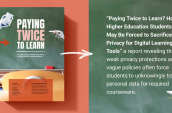Hurricane Sandy hit the northeastern United States in October 2012 leaving thousands of Americans without homes and millions without power. How many of those affected had disaster plans in place? How effective were those plans once executed?
With every natural disaster, we are reminded how important it is to have a plan in place. Good plans require a number of worthy considerations, including having a disaster kit and an evacuation plan. As privacy advocates, we have a narrower focus when it comes to disaster preparedness: control of your personal information.
In August 2010, we published a list of disaster preparedness tips. As America recovers from the devastation caused by superstorm Sandy, we thought now would be a good time to review and update those tips.
- Focus on Redundancy – It's impossible to know what a disaster might bring. A good disaster plan should be flexible enough to work in a wide variety of situations – and that means building in system redundancy. Consider storing your information in more than one place and in more than one format. This might mean storing a copy of important information with a trusted family member, hiring a company to store your information physically or digitally, or all of the above.
- Plan for the Unpredictable – Consider how flooding, power outages, home destruction, and fires may affect how you store your sensitive information. Place documents and devices in waterproof and fire resistant pouches (even the items you place inside your security deposit box). Make a practice of shredding documents you no longer need to reduce what is left behind (and unattended) when disaster strikes. Encrypt hard drives, USB drives and other electronic data to keep it from falling into the wrong hands.
- Pack the Juice – Plan for widespread and long-lasting power outages. Think about what electronic data you might need to access (such as your address book) and how you will access it if there is no power. Purchase back-up batteries or chargers for your phone, tablets and laptops. Consider buying a generator.
- Consolidate Critical Information - Create a list of account numbers and contact information for banking, credit cards, insurance policies, investments, and other financial service providers. Include your checking account's routing number, and basic medical and prescription drug information. Remember to keep this information up-to-date for yourself and family members.
- Protect Your Originals - Be sure that the original copies of important documents (such as birth certificates, wills, marriage certificates, and Social Security cards) are properly secured. You may want to keep the originals in a safe deposit box and to keep the key and a set of photocopies in your portable emergency kit.
- Carry Identification - You may need your driver's license and passport to prove who you are in order to obtain benefits, claim your property, or, if relocated permanently, to apply for a new driver’s license or a new job. Keep your passport (which is not normally something that you carry with you in your wallet) in a secure but accessible place where you can grab it quickly.
- Stash Some Cash - Remember that financial networks may be down after a disaster. ATMs and credit card processing may not be available. So be sure to have a supply of emergency cash for essentials. Small denominations are best.
- Strap it to You – Unfortunately, thieves tend to take advantage of people at their worst, and disasters are no different. Just like when you travel abroad, important documents and cash are safest if they never leave your sight. Use a "waist safe" or "money belt" to secure these items to you.
- Take Photos of Assets – Take a home inventory with photos or video to document all of your valuables for insurance purposes. Store the photos or video footage in a safe place. If you decide to store it "in the cloud" using a service such as Dropbox or Google Docs, be aware of the privacy risks that are inherent in cloud computing. Also, keep in mind that cloud computing services might be subject to disruption from the same disaster that can impact you.
- Be Prepared for Scams - During and after a disaster, scammers are likely to be out in full force to get your personal information. Be cautious when giving out your personal information, particularly your Social Security number. It is the most valuable piece of information to identity thieves.
The key to protecting your privacy, your personal information, and avoiding identity theft is planning ahead. Take a few moments now and be ready if disaster strikes.
Resources:
- Red Cross' Be Red Cross Ready module for disaster preparedness - http://arcbrcr.org/
- PRC's Disasters and Your Privacy - https://www.privacyrights.org/disasters-and-privacy
- PRC's Fact Sheet 12a: Personal Data Retention and Destruction Plan - https://www.privacyrights.org/fs12a-personal-data-retention-and-destruction-plan
- PRC's Fact Sheet 18: Online Privacy: Using the Internet Safely section on cloud computing - https://www.privacyrights.org/fs/fs18-cyb.htm#cloud


